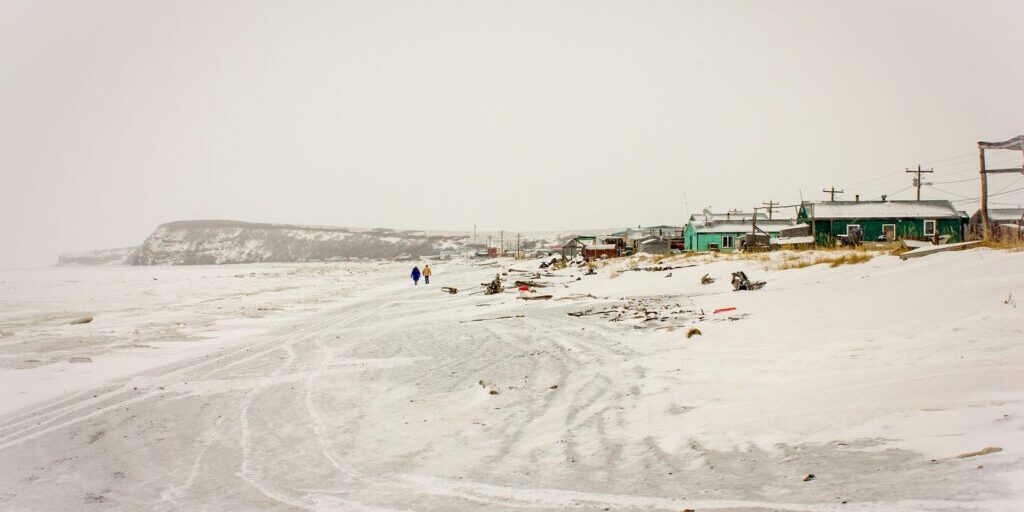Wellness can be about more than exercise and healthy eating. Sometimes, it means learning to heal from trauma and colonization. That was the focus of “Our Youth, a Bright Future,” a three-day symposium held in both the communities of St. Michael and Stebbins January 10-12.
On a Friday afternoon at the Stebbins school, the students are a little restless as they fill the bleachers in the gymnasium. Facing them is a ring of elders and representatives from Kawerak Wellness and Behavioral Health Services. Friday’s school lessons have been replaced with lessons from the local elders.
“They need to hear what it was like in the past, which I have seen. I’m hoping that they will know that their education in this new millennium world is very important, now, and they can also learn their Yup’ik language.”
Minnie Aluska is a teacher at the Stebbins school. Aluska considers Yup’ik to be her first language and has been teaching the language for 19 years.
Elders and students from Kotlik also joined the communities of St. Michael and Stebbins for the three-day symposium. Memories of poverty, residential boarding schools, being removed from family, and loss of the Yup’ik language came forth from some elders. Yet others shared stories of growing up in fish camps and how subsistence made them stronger. Often, the elders stressed to the children the importance of learning their traditional ways.
Panganga Pungowiyi of Kawerak Wellness began with an invitation to a hard conversation.
“We are here today to discuss very difficult things today and tomorrow. And we acknowledge again that we’re not bringing any new information to you. We’re not experts; we only bring what our ancestors have shared with us and that these are the same things your ancestors have shared with you. We’re just here to start the conversation… we’re just breathing life into a conversation that needs to happen more publicly.”
Pungowiyi continued to pry into larger systematic questions about the United States school system. “If our schools have 50-100% Native youth, why are bilingual and cultural programs often the first ones cut?” She asks, “They treat our knowledge as if it is expendable.” In vocational programs, traditional activities like carving or subsistence hunting are not often mentioned as options, she noted.
But more than once in her introduction, she stresses that knowledge of what a community truly needs is always within the community itself. Though Pungowiyi has been working with Kawerak since 2012, she says conversations like these have been happening through Kawerak wellness programs and other organizations in the region for over a decade.
The afternoon’s session was focused on learning through sharing. Afterwards, students were invited to take the microphone and share their thoughts or ask questions.
That intergenerational and community exchange is exactly what Ward Walker hoped for when he organized the event.
“We’re hoping for a better understanding of the history of oppression from outsiders here in the village and a better understanding of how we can move forward as a community with local self-determination with a sense of pride and self-esteem.”
Walker is a clinician for Behavioral Health Services. He’s lived in the area since 1995 and worked as a counselor there for four years.
The symposium began in St. Michael, but the death of a young high school boy the night before changed the course of discussion to one of grief and healing. Originally, Friday’s agenda was meant to include a presentation by Yup’ik writer Harold Napoleon, whose essay “Yuuyaraq” explores the effects of trauma and loss in Alaska Native communities. After a last minute schedule change, Napoleon was not able to join the event.
The community conversation was deepened by a decolonization workshop lead on Saturday afternoon by Pungowiyi. The workshop discussed how colonization has had an impact on communities, particularly Indigenous communities. One aspect of the workshop, Pungowiyi says, is to help people understand that some of what they see in their communities are common symptoms of colonization and trauma.
“Through the normalization, a lot of times, people, especially people of color, feel reaffirmed they feel validated in their experiences. And it gives people a safe space to talk about their trauma or negative experiences.”
And while the workshop gives context, it was still community-led. When creating a timeline for colonization, Pungowiyi gives no dates. Instead, individuals come up with the dates and events that feel significant to their community. Through all of it, the hope is that understanding the past can guide afflicted communities to a better future.
There is a desire for the conversation to continue. Elder and teacher Minnie Aluska wants to see more of these conferences:
“It’s very helpful for these young children to see how we all can relate together as a family and be helping one another… My culture helps me realize who I am and where I came from.”
And there is plenty in the weekend to help families relate. Both Stebbins and Kotlik turn out for two rousing games of basketball that, in the end, yield two victories for Kotlik.
Competition is replaced by camaraderie as we make our way down Main Street, through the –40° cold to huddle up in City Hall for an evening of dancing.
Both the communities of Kotlik and Stebbins take turns to share their songs.
The elders are primarily the ones drumming, while the mostly middle- and high-school students dance with shy smiles on their faces. At the end, we all get up to dance “The Reindeer Love Song.”
Image at top: file photo (2016): the landscape of the Stebbins beachfront, covered in winter snow and ice. Photo: Emily Russell, KNOM.




